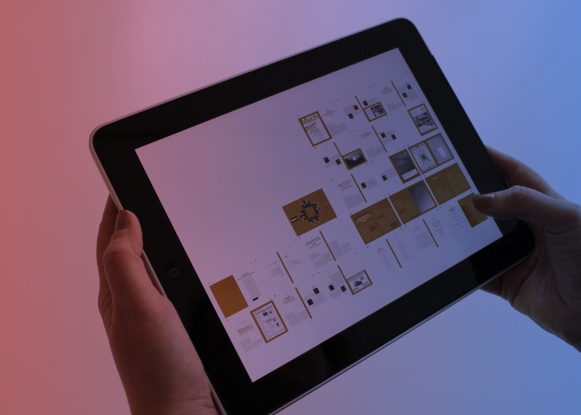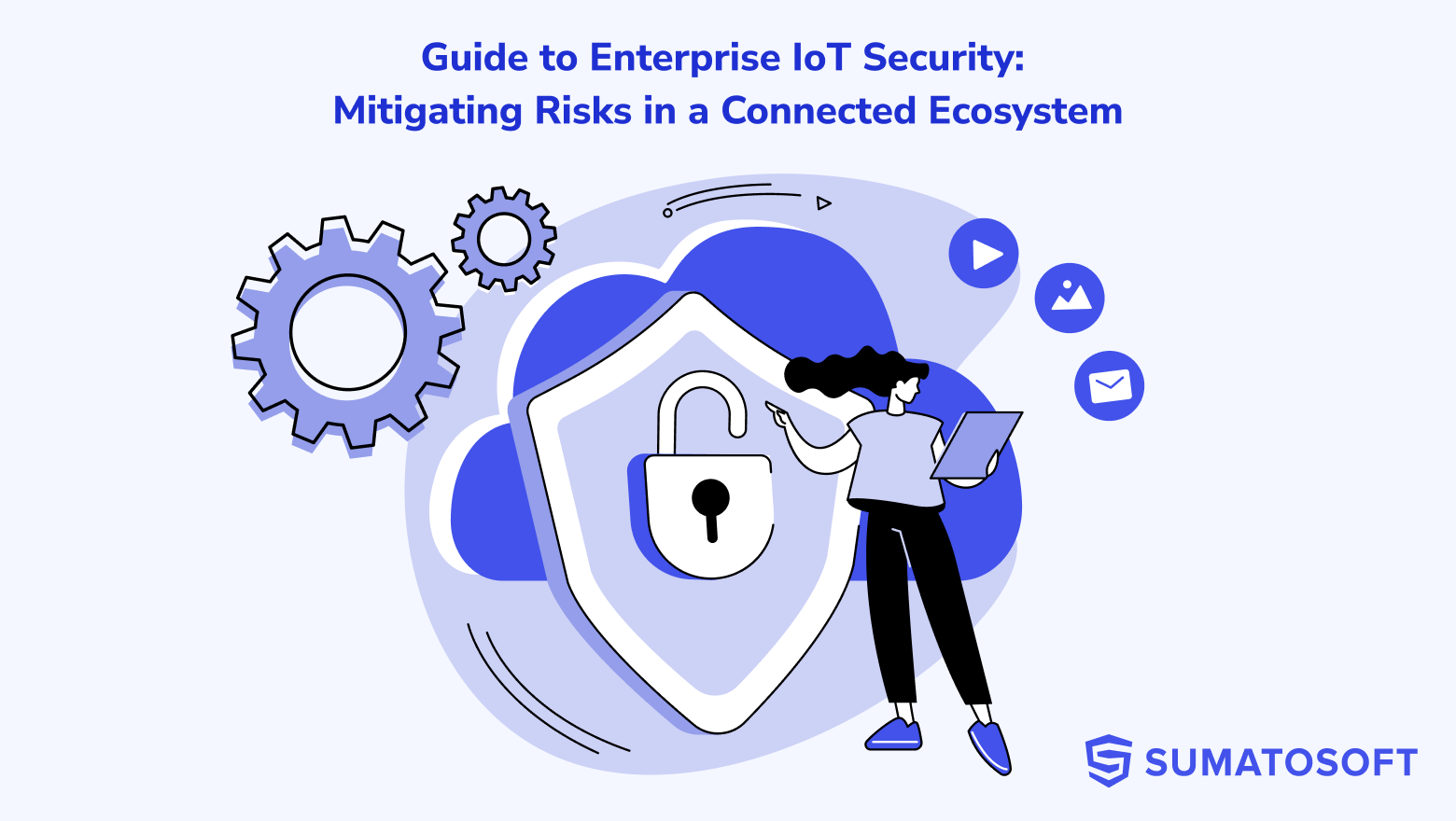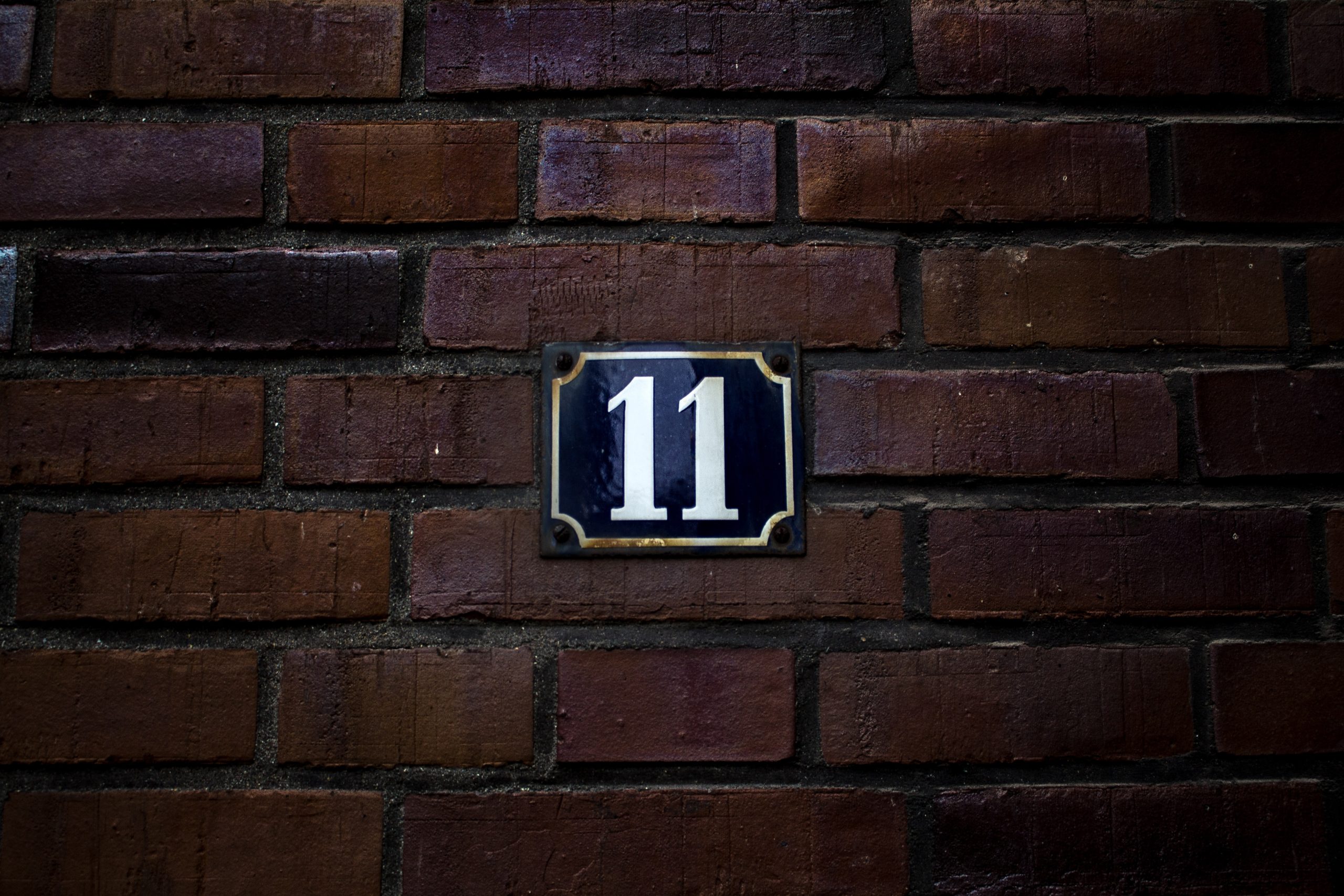IoT and Retail Industry: The Future of Consumer Experiences
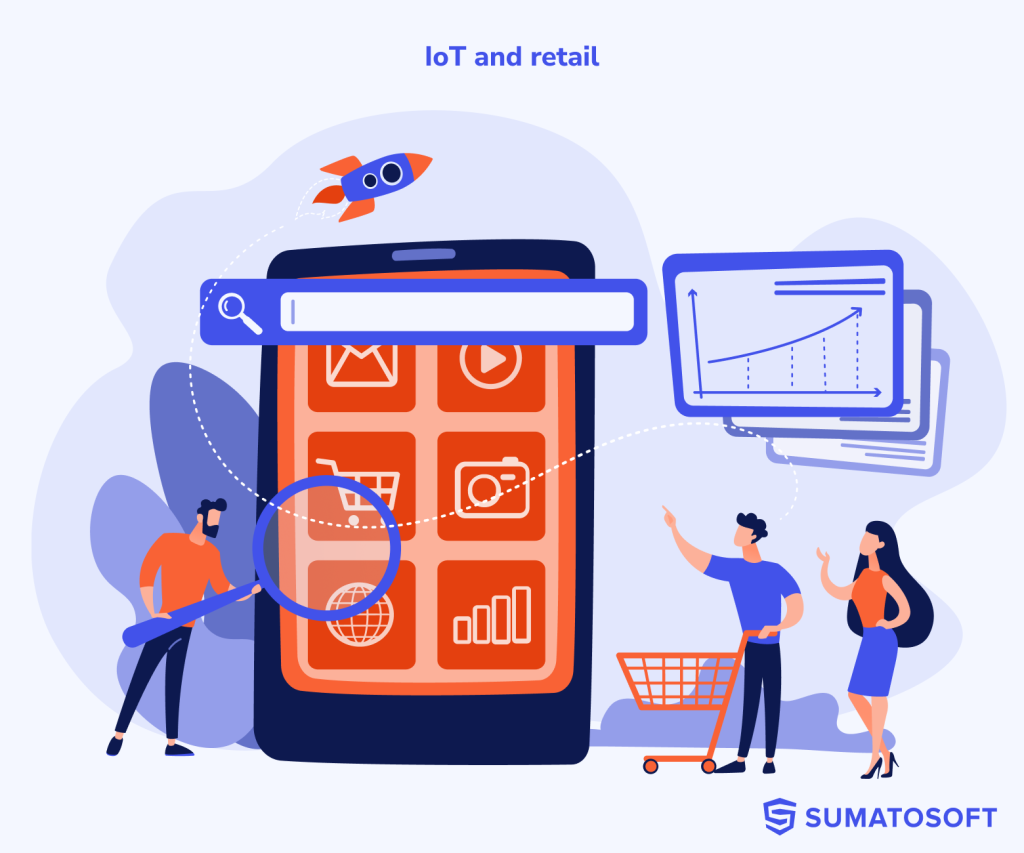
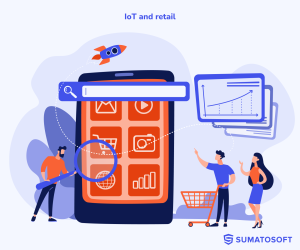
Imagine walking into a store where the shelves communicate with you, the fitting rooms know your size, and the checkout counter has vanished. Welcome to the future of shopping, where the Internet of Things (IoT) is quietly orchestrating every detail.
In my work as an IoT developer at SumatoSoft, I’ve witnessed the practical impact of IoT in retail industry as a part of the supply chain. The transition from traditional systems to more dynamic, data-driven networks is a real opportunity businesses have.
In this article, you’ll discover a comprehensive blend of statistics, industry challenges, and practical applications of IoT in retail industry. All the insights come straight from an expert in IoT implementation who works in the company named the top IoT company in US, Boston by Clutch!
Statistics on IoT and the Retail Industry
- Back in 2017, Stanford University considered the implementation of IoT in retail. These implementations have become a reality today.
- According to Statista, the global retail market experienced growth from $26.18 trillion in 2022 to $28.34 trillion in 2023. It’s projected to reach $37.67 trillion by 2027.
- According to the smart retail global market report, the global smart retail market, a key segment of IoT in retail industry, grew from $34.73 billion in 2022 to $43.73 billion in 2023. It’s expected to surge to $108.37 billion by 2027.
- According to the global data report store, one of the main benefits of IoT in retail industry is the improvement of operational efficiency. Retailers can utilize IoT devices for real-time inventory tracking and management, reducing stockouts and overstock situations, which, in turn, increases sales and reduces inventory costs.
- For more statistics, read our article IoT impact on businesses and economy.
Identifying Key Challenges in Retail: Can IoT Solve Them?
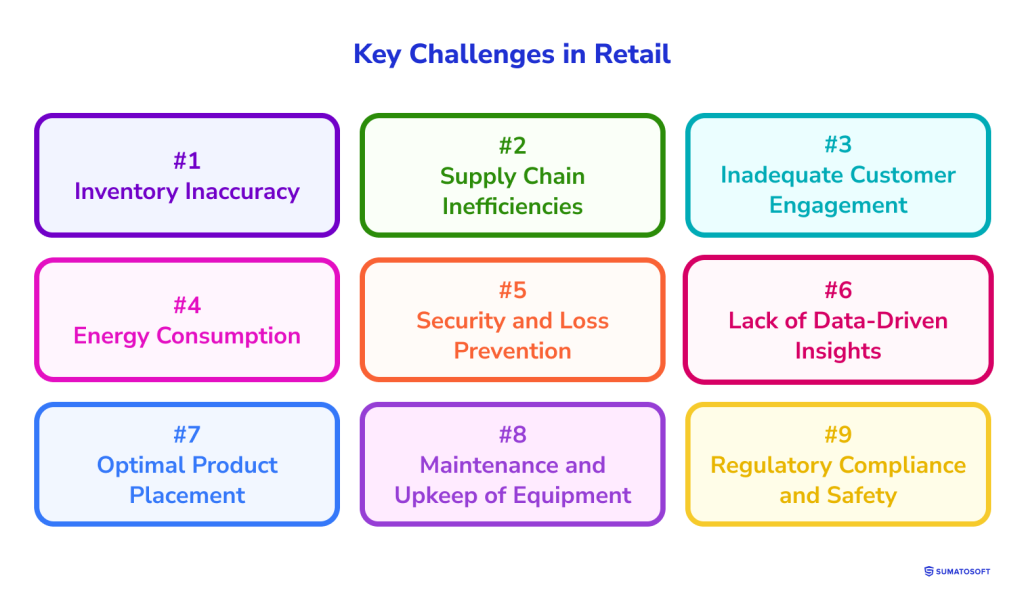
Let’s define the issues before considering if IoT is capable of solving them. There are 9 challenges in retail:
#1 Inventory Inaccuracy
Discrepancies between actual stock and inventory records are normal staff in retail stores. Stockouts and overstocking impact revenue, sales, and customer satisfaction.
#2 Supply Chain Inefficiencies
A lack of visibility and coordination in supply chains results in delays, increased costs, and an inability to respond swiftly to market changes.
#3 Inadequate Customer Engagement
In the era of online shopping, brick-and-mortar retailers’ methods of attracting and retaining customers look quite outdated and ineffective. Standardized in-store promotions, physical loyalty cards, signage – these are the best tools offline stores have.
#4 Energy Consumption
Retail outlets typically consume significant energy, leading to high operational costs and environmental concerns. Efficient energy management is both a cost-saving and a sustainability issue.
#5 Security and Loss Prevention
Retail stores face persistent security challenges despite using surveillance, anti-theft systems, and employee training. Sophisticated theft tactics and internal vulnerabilities render traditional security measures insufficient. Inadequate surveillance coverage and quality further complicate loss prevention efforts, underscoring the need for more advanced security solutions.
#6 Lack of Data-Driven Insights
Transactions info, engagement in loyalty programs, inventory and supplier details, results from offline marketing campaigns, customer feedback, surveys, and patterns of customer activity throughout the day – these are the types of data that retail shops typically collect and analyze. While this data is valuable, it often doesn’t provide a complete picture of customers’ buying habits and patterns.
#7 Optimal Product Placement
Understanding where to place products within a store to maximize sales is a challenge. Retailers need to constantly adjust their strategies based on customer preferences and buying behaviors.
#8 Maintenance and Upkeep of Equipment
Regular maintenance of store equipment (cash registers, scanners, refrigerator units, and others) and infrastructure (lighting, HVAC, escalators/elevators) is necessary to avoid downtime and ensure smooth operations.
#9 Regulatory Compliance and Safety
Retailers must navigate a complex landscape of environmental regulations to ensure compliance and maintain safety. This includes managing solid waste effectively, adhering to specific recycling requirements, and reducing plastic waste as part of a shift towards a circular economy. Additionally, retailers are responsible for the proper management of refrigerants used in cooling systems, which are regulated due to their high global warming potential. They must also handle hazardous and universal waste, such as certain electronics and chemicals, in accordance with environmental laws. Complying with these regulations is critical for retailers to avoid legal penalties and contribute to environmental sustainability.
Integrating IoT in Retail Operations: 12 Implementations
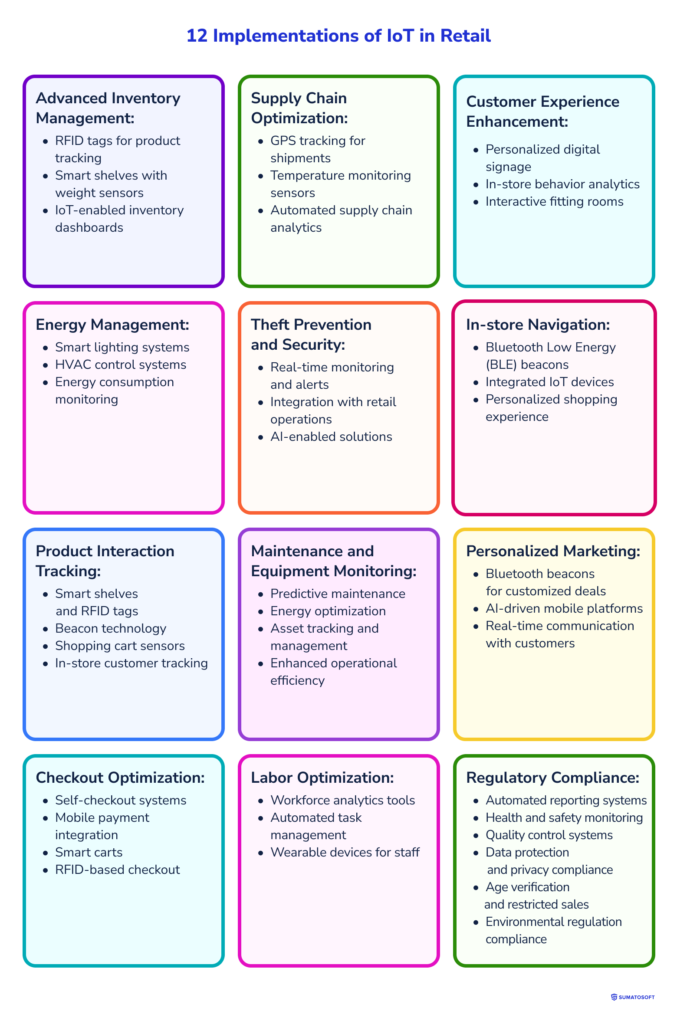
Here I will describe how IoT ecosystem in retail industry is addressing the challenges previously discussed and opening up new opportunities. I’ll give examples of IoT solutions at various stages of adoption; some are widely implemented, while others are emerging concepts with potential for future application.
Although not all implementations have concrete real-world examples yet, their feasibility and potential impact in transforming retail are real. This exploration will highlight how the implementation of IoT infrastructure became both a solution to existing problems but also a driving force shaping the future of the retail sector.
#1 Advanced Inventory Management
Inventory Management in retail involves the tracking and management of stock levels, ensuring products are available when needed and in the right quantities. Effective inventory management is crucial for minimizing costs, reducing waste, and improving customer satisfaction. With the integration of IoT technologies, inventory management becomes more accurate and efficient. C
Cases:
- RFID tags for product tracking. Each product is equipped with an RFID chip for real-time location and stock level tracking, ensuring inventory accuracy.
- Smart shelves with weight sensors. These shelves detect stock changes as items are added or removed, automatically updating inventory levels and signaling when restocking is necessary.
- IoT-enabled inventory dashboards. Sensor and RFID data are compiled into a comprehensive dashboard, offering a real-time overview of inventory status, movement patterns, and potential shortages.
#2 Supply Chain Optimization
Supply Chain Optimization in retail focuses on enhancing the efficiency and transparency of the movement of goods from suppliers to store shelves. It’s crucial for reducing costs, ensuring timely product availability, and responding flexibly to market demands. IoT plays a vital role in this area by providing real-time data and analytics.
Cases:
- GPS tracking for shipments. IoT-enabled GPS devices track the location and condition of goods during transit, providing real-time visibility and helping to predict and manage delivery times.
- Temperature monitoring sensors. For perishable goods, sensors monitor and report the temperature during transportation, ensuring product quality and compliance with safety standards.
- Automated supply chain analytics. IoT devices collect and analyze data throughout the supply chain, enabling predictive analytics for demand forecasting and inventory management.
#3 Customer Experience Enhancement
Customer Experience Enhancement in retail is about enriching the shopping journey for customers, making it more personalized, engaging, and convenient. The integration of IoT in this domain aims to deepen customer engagement and increase satisfaction. IoT in retail industry facilitates a deeper understanding of customer preferences and behaviors, leading to more tailored experiences.
Cases:
- Personalized digital signage. IoT-enabled screens display customized content based on customer demographics or past purchase history, enhancing the shopping experience with relevant information and offers.
- In-store behavior analytics. IoT sensors and cameras analyze customer movement and interaction with products, providing insights that help in tailoring store layout and product placements.
- Interactive fitting rooms. IoT mirrors in fitting rooms can suggest complementary products, offer different size options, or allow customers to request assistance without leaving the fitting room.
#4 Energy Management
Energy Management in retail involves optimizing the use of energy within stores to reduce costs and environmental impact. Efficient energy management is essential for sustainability and operational efficiency. IoT technologies play a significant role in monitoring and managing energy consumption in retail environments.
Cases:
- Smart lighting systems. IoT-enabled lighting automatically adjusts based on natural light availability and occupancy, reducing energy consumption and costs.
- HVAC control systems. IoT devices optimize heating, ventilation, and air conditioning based on real-time data, maintaining comfort while conserving energy.
- Energy consumption monitoring. IoT sensors track real-time energy usage across various store systems, identifying areas for improvement and ensuring efficient energy use.
#5 Theft Prevention and Security
This includes implementing advanced monitoring systems, real-time alerts, and AI-enabled solutions to detect and prevent shoplifting and organized retail crime.
Cases:
- Real-time monitoring and alerts. IoT devices can provide real-time inventory levels and send automated alerts for potential theft activities, such as when an item is removed from the shelf. This allows for immediate response to any suspicious activity.
- Integration with retail operations. IoT in retail industry loss prevention devices can connect to various internet-based devices, such as inventory management programs, POS systems, and mobile devices. This integration facilitates a more comprehensive approach to loss prevention.
- AI-enabled solutions. Collaborations, such as between NVIDIA and the Loss Prevention Research Council, are introducing AI solutions to combat organized retail crime. These solutions provide advanced notifications of suspicious behavior, both inside and outside stores, enabling early intervention.
#6 In-store Navigation
In-store Navigation as an implementation of IoT in retail industry is about enhancing the customer’s shopping experience by making it easier for them to find products and navigate through the store.
Cases:
- Bluetooth Low Energy (BLE) beacons. These small sensors placed throughout the store send signals to nearby smartphones. When a customer with a smart device enters the range of a beacon, they receive notifications such as product availability or special offers.
- Integrated IoT devices. Technologies like Bluetooth, Wi-Fi, and augmented reality integrated into IoT devices facilitate easier navigation inside the store. Customers can use their smartphones to receive real-time guidance to find the products they’re looking for, enhancing the overall shopping process.
- Personalized shopping experience. By digitizing physical assets and utilizing in-store navigation, retailers provide a multichannel shopping experience. This technology also helps increase the path to purchase rate by guiding customers to products before they are out of stock.
#7 Product Interaction Tracking
In the category of Product Interaction Tracking, IoT technology is used to analyze how customers interact with products in-store. This information is vital for marketing strategies and inventory management.
Cases:
- Smart shelves and RFID tags. Products equipped with RFID tags on smart shelves provide real-time data on customer interactions with products, like the frequency of being picked up or moved.
- Beacon technology. Beacons in the store interact with customer smartphones to send personalized offers when near certain products, providing insights into customer preferences.
- Shopping cart sensors. These sensors track the movement of shopping carts within the store, offering data on shopping patterns and popular areas.
- In-store customer tracking. IoT devices track customer movements in the store to understand behavior and areas of interest.
#8 Maintenance and Equipment Monitoring
Maintenance and equipment monitoring in retail involves using IoT technology for predictive maintenance, energy management, and ensuring efficient operation of store equipment.
Cases:
- Predictive maintenance. IoT sensors embedded in equipment like HVAC systems monitor for anomalies, allowing for maintenance before issues escalate, reducing downtime and costs.
- Energy optimization. IoT devices manage energy consumption, such as lighting systems adjusting based on occupancy, contributing to significant energy savings.
- Asset tracking and management. Real-time monitoring and tracking of store equipment through IoT technology ensure optimal functioning and efficiency.
- Enhanced operational efficiency. Integration with Computerized Maintenance Management Systems (CMMS) streamlines maintenance processes and optimizes energy usage.
#9 Personalized Marketing
Personalized Marketing in retail, facilitated by IoT in retail industry, is about creating unique, tailored experiences for customers to enhance engagement and loyalty.
Cases:
- Bluetooth beacons for customized deals. Retailers like Redbox use Bluetooth beacons to send personalized offers and information to customers’ mobile devices when they are near a kiosk. This technology engages customers with relevant content based on their location and previous interactions.
- AI-driven mobile platforms. Companies like Plexure utilize AI-driven platforms that deliver personalized messages and promotions to customers on their mobile devices. This approach helps retailers send the right messages at the right times, significantly increasing customer engagement and sales.
- Real-time communication with customers. IoT allows for direct connection with customers’ devices in-store, offering personalized deals, assistance in finding products, and easy checkout options. This interaction tailors the buying process to each shopper, increasing customer engagement and potential sales.
#10 Checkout Optimization
It involves employing IoT technologies to streamline and enhance the checkout process in retail environments. The objective is to reduce wait times, improve customer satisfaction, and increase operational efficiency.
Cases:
- Self-checkout systems. Automated checkout stations where customers scan and pay for their items without cashier assistance. These systems often use IoT technologies for item recognition and payment processing, leading to shorter lines and quicker transactions.
- Mobile payment integration. The integration of mobile payment solutions with IoT enables customers to pay using smartphones or wearable devices. This technology simplifies the payment process and can include options like contactless payments or QR code scanning.
- Smart carts. Carts equipped with IoT technologies that can scan items as they are added, allowing for instant checkout. This can significantly reduce the time customers spend in checkout lines.
- RFID-based checkout. Utilizing RFID technology to scan all items in a cart simultaneously eliminates the need for individual barcode scanning. This approach can drastically speed up the checkout process.
#11 Labor Optimization
Retails can leverage IoT to streamline workforce management and optimize staff deployment in retail settings.
Cases:
- Workforce analytics tools. IoT devices and sensors collect data on customer traffic and staff activities, enabling managers to analyze workforce efficiency and optimize staff scheduling according to peak times and customer demand.
- Automated task management. IoT systems can automate routine tasks, such as inventory tracking or cleaning schedules, allowing staff to focus on more customer-centric activities. This helps in improving overall service quality.
- Wearable devices for staff. Wearable IoT devices for employees can facilitate communication, provide task notifications, and track task completion. These devices help in coordinating staff efforts more effectively and ensure timely completion of tasks.
#12 Regulatory Compliance
This aspect of retail operations involves leveraging IoT technology to ensure adherence to a wide range of legal, ethical, and industry-specific regulations. Examples are: Federal Trade Commission (FTC), Occupational Safety and Health Administration (OSHA) guidelines in the U.S., Food Safety Modernization Act (FSMA), Resource Conservation and Recovery Act (RCRA), and more.
Cases:
- Automated reporting systems. IoT devices can automatically collect and report data required for regulatory compliance, such as environmental conditions (temperature, humidity) for perishable goods, ensuring that they are stored and handled according to legal standards.
- Health and safety monitoring. IoT sensors monitor and ensure compliance with health and safety regulations. For example, sensors can detect hazardous conditions like gas leaks or inadequate lighting and alert management for immediate action.
- Quality control systems. IoT technologies help in maintaining quality standards for products. This includes monitoring the conditions of goods throughout the supply chain, ensuring that products meet industry quality standards.
- Data protection and privacy compliance. With the increasing importance of data protection regulations (like GDPR), IoT devices in retail are designed to securely handle customer data, ensuring privacy and compliance with data protection laws.
- Age verification and restricted sales. IoT systems can automate the process of age verification for restricted products, ensuring compliance with legal age limits and reducing the risk of human error in sales of age-restricted items.
- Environmental regulation compliance. IoT can help retailers comply with environmental regulations by monitoring and managing energy consumption, waste production, and recycling processes.
SumatoSoft’s Expertise in IoT Retail
SumatoSoft has been delivering IoT software development services since 2012, delivering custom enterprise software and developing MVPs to startups gain a competitive advantage and improve their efficiency, effectiveness, and profit through business digitalization.
SumatoSoft offers industry-focused IoT solutions in multiple domains. They include:
- the Internet of Things in logistics;
- IoT solutions for smart cities;
- the Internet of Things in climate change;
- IoT development for fleet management;
- healthcare IoT development;
- IoT for remote monitoring;
- big data and IoT development;
- retail;
- manufacturing;
- automotive.
Every solution SumatoSoft builds comes with excellent security and scalability for future changes in terms of new features, fleet expansion, new users, and increased workload.
SumatoSoft IoT services include:
- all-around IoT applications;
- connectivity management;
- device management;
- data visualization;
- IoT data analytics;
- IoT consulting.
SumatoSoft succeeded in building a more manageable solution that is much easier to maintain.
Although they are a small team, their project management reflects the excellence of a larger company. Their team delivers high-quality results, attentive service, and reasonable pricing.
The SumatoSoft team has built 250 custom software solutions for 27 countries for 11 industries. After more than 12 years on the market, the company became a reliable technical partner to its Clients, demonstrating a 98% Client satisfaction rate with the quality of services they provide.
Contact us to get a free quote for your project.
Afterwords
As retail businesses continue to navigate the evolving demands of the digital age, the adoption and integration of IoT solutions will play a pivotal role in their success. As you have seen, the potential of IoT to revolutionize retail operations is immense, offering opportunities for businesses to grow, innovate, and excel in an increasingly competitive market.
I want to finish the article about the role of IoT in retail industry with one line I enjoy:
The ongoing journey of IoT in retail is not just about adopting new technologies; it’s about embracing a new way of thinking and operating in the retail world.
Let’s start
If you have any questions, email us info@sumatosoft.com


